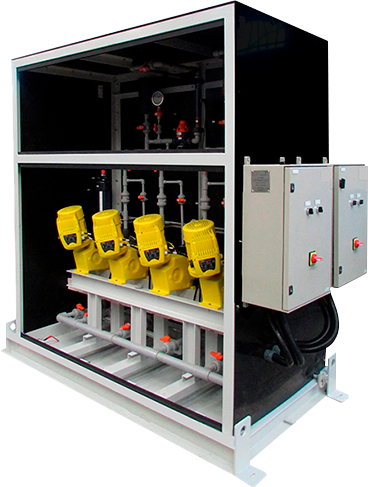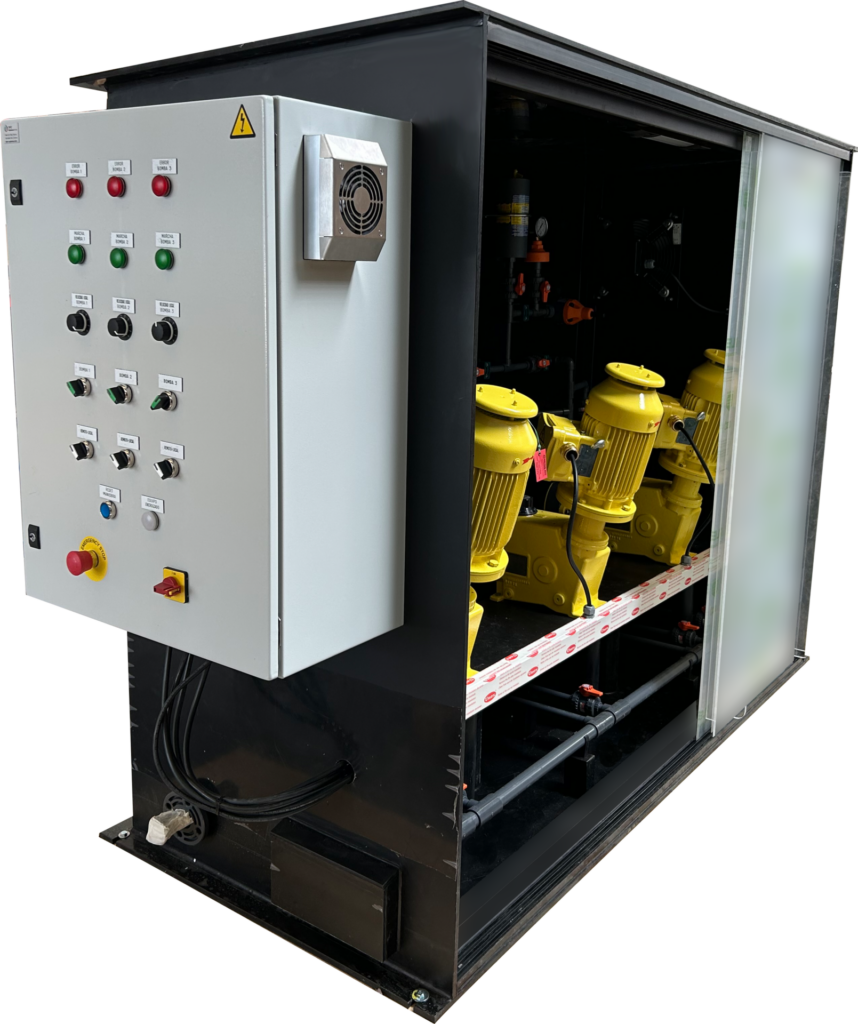
A chemical dosing skid is a self-contained unit used in industrial processes to precisely inject chemicals into a system. It consists of various components and instruments that work together to ensure the controlled supply of chemicals in a safe and efficient manner.
KLINGER Portugal presents it as a compact unit, which is supplied fully assembled, all that is needed is to anchor the unit and make the hydraulic and electrical connections. The design of the DOSAPACK PD unit includes all the necessary elements, positioned appropriately to guarantee the optimization of dosing processes.
HOW DOES IT WORK?
A dosing skid works by precisely delivering a predetermined amount of chemical into a larger industrial process. Here’s how a typical dosing skid works:
Storage and preparation of the chemical: The dosing skid is connected to a reservoir or tank where the chemical to be dosed is stored. Before starting the dosing process, the chemical is prepared if necessary and its properties checked.
Starting the dosing process: The dosing process is started manually or via an automated control system. The operator can set parameters such as the desired flow rate, the total volume to be dosed or any specific timing or sequencing requirements.
Flow control: The dosing skid pumps are suitable for creating a controlled flow of chemical. The flow rate is carefully adjusted based on the quantity required and the characteristics of the chemical being dosed.
Feedback and control circuit: The control system is very usually based on measuring the flow rate using a flow meter in the main line and dosing the chemical to be dosed proportionally to the flow rate. If the flow rate in the main line changes, the system adjusts the amount of product dosed by the dosing skid pumps.
Monitoring and safety: Throughout the dosing process, various sensors and components can monitor parameters such as pressure, temperature, the presence of fluid, etc. For system safety, pressure relief valves and leak detection systems are used, among others.
Completion and reporting: When the process is finished, the control system can generate process records or reports, which can be used for process analysis and for operation and maintenance control.
Maintenance and calibration: Regular maintenance and calibration of dosing system components is crucial to ensure accurate and reliable dosing. This includes checking the accuracy of flow meters, calibrating pumps and checking the functionality of safety components.
In conclusion, a dosing skid works through a combination of pumps, flow meters, control systems and safety features to deliver chemicals accurately and safely in an industrial process. The process is automated and closely monitored to ensure that the desired dosage is achieved while maintaining the safety and efficiency of the process.
KEY COMPONENTS:


APPLICATIONS:
Many companies in various sectors use dosing skids as part of their industrial processes. Some sectors where dosing skids are commonly used:

Water treatment: Municipal water treatment plants and industrial facilities use dosing skids to add chemicals such as coagulants, flocculants, disinfectants and pH regulators to ensure the quality and safety of treated water.
Chemical production: Chemical production plants use dosing skids to precisely mix and combine raw materials, as well as to dose catalysts, inhibitors and other additives.
Pharmaceutical products: In the manufacture of pharmaceutical products, dosing skids are used to precisely add active pharmaceutical ingredients, excipients and other components in the production of medicines and pharmaceutical products.
Food and drink: The food and beverage industry uses dosing systems to add flavorings, colorings, preservatives and other ingredients to achieve consistent flavors and product quality.
Oil and gas: Dosing skids are used in oil and gas processing to inject chemicals for corrosion inhibition, scale control and other treatments to improve the efficiency and safety of operations.
Pulp and paper: In the pulp and paper industry, dosing skids are used to add chemical products such as bleaching agents and bonding agents to pulp and paper production.
Wastewater treatment: Industrial and municipal facilities use Dosing Skids for wastewater treatment, adding chemicals that help remove contaminants, adjust pH levels and promote effective treatment processes.
Mining: The mining industry uses dosing systems to add chemicals for ore processing, water treatment and environmental management.
Textiles: The textile industries use dosing systems to apply dyes and other chemicals to fabrics and materials.
Automotive sector: Car factories use dosing skids to add fluids such as coolant, lubricants and cleaning agents during production processes.
These are just a few examples and the use of dosing skids extends to many other sectors where precise and controlled dosing of chemical products is essential to achieve the specific objectives of each process.
